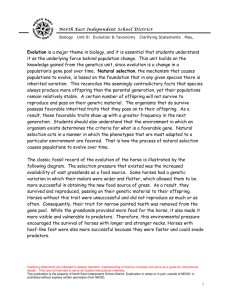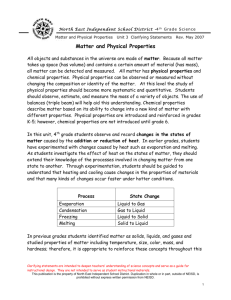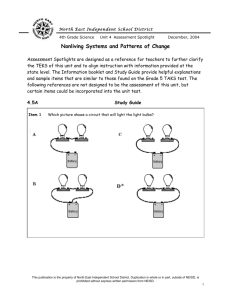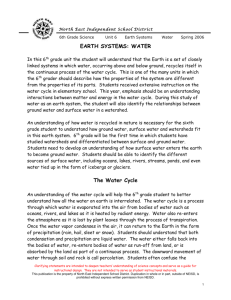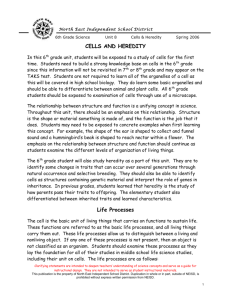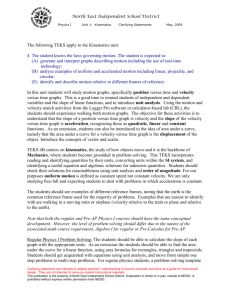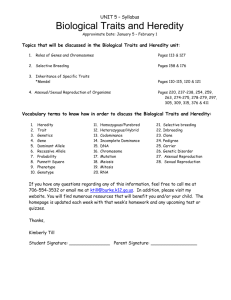Heredity & Environment - North East Independent School District
advertisement
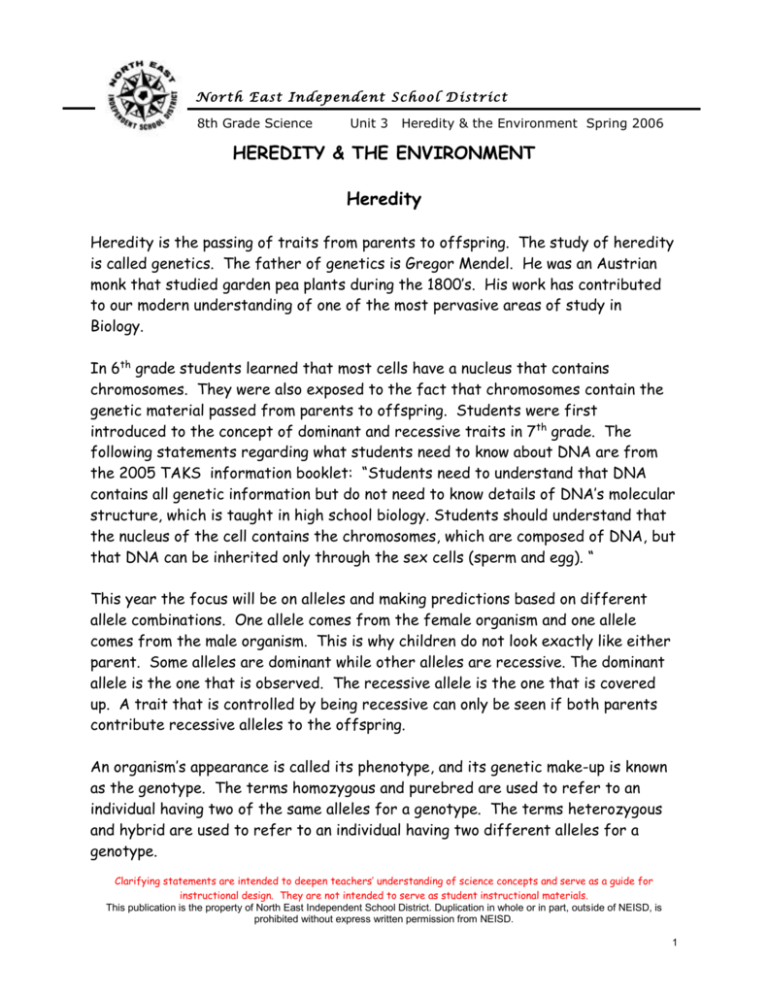
N o r t h E a st I n d ep en d e nt S c h o o l D i st ric t 8th Grade Science Unit 3 Heredity & the Environment Spring 2006 HEREDITY & THE ENVIRONMENT Heredity Heredity is the passing of traits from parents to offspring. The study of heredity is called genetics. The father of genetics is Gregor Mendel. He was an Austrian monk that studied garden pea plants during the 1800’s. His work has contributed to our modern understanding of one of the most pervasive areas of study in Biology. In 6th grade students learned that most cells have a nucleus that contains chromosomes. They were also exposed to the fact that chromosomes contain the genetic material passed from parents to offspring. Students were first introduced to the concept of dominant and recessive traits in 7th grade. The following statements regarding what students need to know about DNA are from the 2005 TAKS information booklet: “Students need to understand that DNA contains all genetic information but do not need to know details of DNA’s molecular structure, which is taught in high school biology. Students should understand that the nucleus of the cell contains the chromosomes, which are composed of DNA, but that DNA can be inherited only through the sex cells (sperm and egg). “ This year the focus will be on alleles and making predictions based on different allele combinations. One allele comes from the female organism and one allele comes from the male organism. This is why children do not look exactly like either parent. Some alleles are dominant while other alleles are recessive. The dominant allele is the one that is observed. The recessive allele is the one that is covered up. A trait that is controlled by being recessive can only be seen if both parents contribute recessive alleles to the offspring. An organism’s appearance is called its phenotype, and its genetic make-up is known as the genotype. The terms homozygous and purebred are used to refer to an individual having two of the same alleles for a genotype. The terms heterozygous and hybrid are used to refer to an individual having two different alleles for a genotype. Clarifying statements are intended to deepen teachers’ understanding of science concepts and serve as a guide for instructional design. They are not intended to serve as student instructional materials. This publication is the property of North East Independent School District. Duplication in whole or in part, outside of NEISD, is prohibited without express written permission from NEISD. 1 N o r t h E a st I n d ep en d e nt S c h o o l D i st ric t 8th Grade Science Unit 3 Heredity & the Environment Spring 2006 Using capital letters to represent dominant alleles and small letters to represent recessive alleles, predictions can be made about possible outcomes of certain crosses using a chart known as a Punnett square. For example, in Mendel’s garden pea plant, the trait for purple flowers (P) is dominant over the trait for white flowers (p). The letter P is used since it corresponds to purple, the dominant trait. PP would be a homozygous purple pea plant whereas pp would be a homozygous white pea plant. Pp would be a heterozygous purple pea plant. In 6th grade students talked about selective breeding. This would be a good time to make the connection between prior learning and the process of predicting genetic outcomes. The 2005 TAKS information booklet states that students will be held accountable for single-trait Punnett squares. Dihybrid crosses will be encountered in high school biology. The following is an example of a problem students should be able to complete at this level: Alleles: Cross: Pp X pp Punnett square: Clarifying statements are intended to deepen teachers’ understanding of science concepts and serve as a guide for instructional design. They are not intended to serve as student instructional materials. This publication is the property of North East Independent School District. Duplication in whole or in part, outside of NEISD, is prohibited without express written permission from NEISD. 2 N o r t h E a st I n d ep en d e nt S c h o o l D i st ric t 8th Grade Science Unit 3 Heredity & the Environment Spring 2006 Phenotype Results: 50% purple and 50% white or 1:1 purple/white Genotype Results: 0% homozygous purple, 50% heterozygous purple, 25% homozygous recessive or white Given the number of individuals, students should calculate to apply the percentage to a given number of offspring for any genotype. For example, students should be able to calculate the following problem: What is the probability of obtaining heterozygous offspring from the cross above (Pp X pp) if there are 8 offspring? = 4 out of 8 or 50%. If there are 16 offspring? = 8 out of 16 or 50%. Given the genotypes of the offspring of a cross, students should also be able to predict the genotypes of the parents. The following problem provides an example: Students do not have to know which is the dominant trait in a situation. The dominant and recessive forms of the trait have to be given. Students should understand the results given in a Punnett square do not mean that the results would be exactly that way. It does, however, tell what the probability is of having that outcome. On TAKS, students may be asked to record these percentages as griddable items. Mendel discovered that not all organisms have traits that are either dominant or recessive. For example if a red flower is crossed with a white flower and the result is a pink flower, then Mendel called this phenomenon incomplete dominance. Clarifying statements are intended to deepen teachers’ understanding of science concepts and serve as a guide for instructional design. They are not intended to serve as student instructional materials. This publication is the property of North East Independent School District. Duplication in whole or in part, outside of NEISD, is prohibited without express written permission from NEISD. 3 N o r t h E a st I n d ep en d e nt S c h o o l D i st ric t 8th Grade Science Unit 3 Heredity & the Environment Spring 2006 This means that each allele from each parent has equal influence. There are also other traits that are determined by multiple alleles. This is important for students to understand when questions regarding traits such as height, hair and skin color arise. The following chart contains some examples of traits in humans that are controlled by a single pair of alleles: DOMINANT TRAITS RECESSIVE TRAITS unattached earlobes attached earlobes straight thumb hitchhiker’s thumb Source: http://extension.usu.edu/aitc/teachers/pdf/heredity/comparing_traits.pdf Source: http://extension.usu.edu/aitc/teachers/pdf/heredity/comparing_traits.pdf can roll tongue cannot roll tongue freckles no freckles Source: http://extension.usu.edu/aitc/teachers/pdf/heredity/comparing_traits.pdf Source: http://extension.usu.edu/aitc/teachers/pdf/heredity/comparing_traits.pdf naturally rests left thumb on top when hands are folded naturally rests right thumb on top when hands are folded dimples no dimples Clarifying statements are intended to deepen teachers’ understanding of science concepts and serve as a guide for instructional design. They are not intended to serve as student instructional materials. This publication is the property of North East Independent School District. Duplication in whole or in part, outside of NEISD, is prohibited without express written permission from NEISD. 4 N o r t h E a st I n d ep en d e nt S c h o o l D i st ric t 8th Grade Science DOMINANT TRAITS Unit 3 Heredity & the Environment Spring 2006 RECESSIVE TRAITS middigital hair no middigital hair widow’s peak no widow’s peak The Effect of Environmental Conditions on Traits Environment may also influence characteristics. A person who is exposed to more learning experiences may be more successful than a person that has not had those experiences. Two people may have differing weights due to diet and exercise and may not because of genetic inheritance. Some organisms are affected by temperature. For example, the arctic fox’s fur is brown in summer because pigments are made when the temperature is higher. When the temperature drops, pigments to darken the fur are not made and the arctic fox’s fur is white in winter. This is also clearly an adaptation that has evolved to help the arctic fox survive by providing protective coloration for different seasons. Any trait that improves the chances for survival is known as an adaptation. The 7th grade student studied adaptations and received the first introduction to the theory of natural selection. Natural Selection Species that have the most favorable traits are the ones that survive and reproduce. This is known as the theory of natural selection. Charles Darwin proposed the theory of natural selection in an attempt to explain why some species have survived while others have not been successful. The theory has four main Clarifying statements are intended to deepen teachers’ understanding of science concepts and serve as a guide for instructional design. They are not intended to serve as student instructional materials. This publication is the property of North East Independent School District. Duplication in whole or in part, outside of NEISD, is prohibited without express written permission from NEISD. 5 N o r t h E a st I n d ep en d e nt S c h o o l D i st ric t 8th Grade Science Unit 3 Heredity & the Environment Spring 2006 points: overproduction, genetic variation, struggle to survive, and successful reproduction. overproduction: In an effort to allow a population to survive most organisms will produce more offspring than is needed. In general, the more parental care needed, the fewer the offspring. In some cases, more offspring are produced to increase the odds of survival for species that are not well protected by parents. genetic variation: Among the many individuals of a single population of species there exists variation. A great example of how this can help a species survive is the example of the peppered moths of England. Within the population some of the moths were black, some were white, and others were gray. Before the Industrial Revolution, most of the tree barks were white and the white moth was camouflaged and protected from extensive predation by birds. However, after the Industrial Revolution began, coal soot made the bark of the trees very dark. Had all the moth’s been white then the species might have become extinct. The grey and black moths were now camouflaged, protected from extensive predation, and the moths lived on. To illustrate this concept, many teachers conduct an activity utilizing moths cut out of newspaper and black construction paper. The moths are laid down on a background of newspaper and a student is given a short amount of time to pick up as many moths as possible. When the moths are counted, more black moths should have been “preyed upon” than the camouflaged newspaper moths. struggle to survive: All species compete for food, water, air, and habitat (a place to live). Those species that have the adaptations best suited to the environment are the ones most likely to survive. successful reproduction: Individuals do not have to reproduce in order to survive, however, some individuals in a population have to reproduce or the species will die out. The organisms that are best adapted are going to be Clarifying statements are intended to deepen teachers’ understanding of science concepts and serve as a guide for instructional design. They are not intended to serve as student instructional materials. This publication is the property of North East Independent School District. Duplication in whole or in part, outside of NEISD, is prohibited without express written permission from NEISD. 6 N o r t h E a st I n d ep en d e nt S c h o o l D i st ric t 8th Grade Science Unit 3 Heredity & the Environment Spring 2006 the ones who reproduce and this allows the species to continue its survival in nature. Natural selection is the process that may lead to evolution and speciation. Evolution is the process of change in a species over time. Adaptations are examples of evolution on a small scale. Genetic variation may lead to differences in one population of a species. If this population becomes different enough, speciation may occur. Speciation is the formation of a new species which is now reproductively isolated from those they could have once mated with. The following is an example of how this occurred in a squirrel population: Factors that Contribute to Extinction Extinction of a species happens when all members of that species die out. The fossil record shows that over time there have been many mass extinctions. Probably the most well known is the death of the dinosaurs at the end of the Clarifying statements are intended to deepen teachers’ understanding of science concepts and serve as a guide for instructional design. They are not intended to serve as student instructional materials. This publication is the property of North East Independent School District. Duplication in whole or in part, outside of NEISD, is prohibited without express written permission from NEISD. 7 N o r t h E a st I n d ep en d e nt S c h o o l D i st ric t 8th Grade Science Unit 3 Heredity & the Environment Spring 2006 Mesozoic Era. Scientists estimate that there are about 5 million species on earth. Extinction is a natural process that has occurred since the beginning of life. Usually, this process occurs very slowly and only affects a small number of species. However, today plants and animal species are dying out at an alarming rate. The world is a healthier place when there is a balance among species. Biodiversity or a variety of species leads to a more stable environment. The following are examples of how human events may contribute to extinction: Habitat loss and destruction - probably the #1 reason on earth today Pollution - any addition to the environment that hurts the life of a species, including smog, noise, pesticide usage etc. Over-consumption and/or unregulated hunting - when man over hunts or fishes an area and this action depletes the area of its species Foreign animal trade – capturing and/or killing species for profit Introduced species (invasive, non-native, alien) - bringing in an unknown species to a new environment and then the new species begins to take over the food and habitats or niche of the endangered species The following examples are a result of extinctions due to natural occurrences: Climate change such as an ice age Geologic changes such as volcanic eruptions Large asteroid strikes Earth and triggers world–wide habitat changes Catastrophic events such as hurricanes Students should also understand that negative impacts on the environment from human activity does not necessarily lead to extinction. According to the TAKS information booklet, students should understand “that there may be degrees of consequences.” They should know “there may be a more gradual process that allows for recovery, as with the American bald eagle.” Clarifying statements are intended to deepen teachers’ understanding of science concepts and serve as a guide for instructional design. They are not intended to serve as student instructional materials. This publication is the property of North East Independent School District. Duplication in whole or in part, outside of NEISD, is prohibited without express written permission from NEISD. 8 N o r t h E a st I n d ep en d e nt S c h o o l D i st ric t 8th Grade Science Unit 3 Heredity & the Environment Spring 2006 Interactions within Ecosystems The 8th grade student should be able to distinguish between inherited and learned traits. In addition, they need to gain an understanding that some traits are influenced by both heredity and the environment. A good example of this would be an animal whose fur changes color in winter. The 8th grade student also looks at interactions within the environment through very specific relationships. The concepts of limiting factors and carrying capacity are studied for the first time. An ecosystem represents all of the populations that live in an area and the abiotic factors that influence these populations. Each species needs food, habitat, and water. Those resources that are needed by a population are called limiting factors. Limiting factors determine how large a population can be. The term carrying capacity refers to the largest numbers of individuals in a population that an ecosystem can support. If the population gets too large, then lack of food, water, or habitat becomes an issue and usually some of the population dies out. Organisms compete for earth’s resources. The ones who get them survive and the ones who don’t get them die out. The following chart shows the normal ebb and flow in population size once the carrying capacity is reached: Clarifying statements are intended to deepen teachers’ understanding of science concepts and serve as a guide for instructional design. They are not intended to serve as student instructional materials. This publication is the property of North East Independent School District. Duplication in whole or in part, outside of NEISD, is prohibited without express written permission from NEISD. 9 N o r t h E a st I n d ep en d e nt S c h o o l D i st ric t 8th Grade Science Unit 3 Heredity & the Environment Spring 2006 Interactions between organisms within an ecosystem can be illustrated to show energy transfer in the form of a food chain or food web. Students were first introduced to food chains in 2nd grade and have revisited this concept in the years since. This would be an appropriate time, however, to insure students understand the food chain and web are models of energy transfer from one organism to the next. They should also understand that all food chains must begin with a producer which is reliant on radiant energy. Food webs at this level should include decomposers. Students should be able to identify the consumers as primary, secondary, etc. and whether they are herbivores, carnivores or omnivores. According to the 2005 TAKS information booklet, food chains and webs should include “examples from Texas or the southwestern United States in addition to global examples.” The following food chain is from an aquatic ecosystem. Students can expand on their understanding of ecology by being exposed to examples of chains and webs from diverse ecosystems. The following food web is an example from the grasslands of Africa. When students look at food webs such as this, they should be reminded that diagrams are examples of models. Whenever models are addressed in the classroom, Clarifying statements are intended to deepen teachers’ understanding of science concepts and serve as a guide for instructional design. They are not intended to serve as student instructional materials. This publication is the property of North East Independent School District. Duplication in whole or in part, outside of NEISD, is prohibited without express written permission from NEISD. 10 N o r t h E a st I n d ep en d e nt S c h o o l D i st ric t 8th Grade Science Unit 3 Heredity & the Environment Spring 2006 students should be asked to identify limitations of that model (per TEKS 8.3C). A hint at a limitation can easily be noted in this example through the title which names the web as “partial,” meaning that not all organisms in the ecosystem are represented. Another example of a limitation would be that this web is not representative of all African grasslands. Clarifying statements are intended to deepen teachers’ understanding of science concepts and serve as a guide for instructional design. They are not intended to serve as student instructional materials. This publication is the property of North East Independent School District. Duplication in whole or in part, outside of NEISD, is prohibited without express written permission from NEISD. 11 N o r t h E a st I n d ep en d e nt S c h o o l D i st ric t 8th Grade Science Unit 3 Heredity & the Environment Spring 2006 Predation: When one animal eats another animal for its food then that animal is known as a predator. The animal that gets eaten is called the prey. There has to be a balance between the predator/prey relationship for the environment to be stable. The following graph shows the normal changes in population sizes that occur as a result of predator – prey interaction: Predators may have speed, good eyesight, sharp claws, sharp teeth just to name a few adaptations that help predators capture their prey. The animals that are considered prey also have adaptations that help them to escape being eaten. Some of these adaptations might be camouflage or coloring that helps the prey blend into the environment, bright colors which usually tells the predator to stay away because the prey is poisonous. Some populations live in great numbers to protect each other. Anything that helps the prey to escape being eaten would be considered an adaptation. Symbiosis: When two organisms live in close proximity and establish a relationship by which at least one of them benefits, this is known as symbiosis. There are three types of symbiosis, including mutualism, commensalism, and parasitism. Clarifying statements are intended to deepen teachers’ understanding of science concepts and serve as a guide for instructional design. They are not intended to serve as student instructional materials. This publication is the property of North East Independent School District. Duplication in whole or in part, outside of NEISD, is prohibited without express written permission from NEISD. 12 N o r t h E a st I n d ep en d e nt S c h o o l D i st ric t 8th Grade Science Unit 3 Heredity & the Environment Spring 2006 Mutualism: In a mutualistic relationship, both organisms help each other without harm coming to either one. The clown fish and sea anemone provide an excellent example of this type of relationship. The clown fish is coated with a mucous that protects it from the stinging tentacles of the anemone. When the clown fish is between these tentacles, it is protected from predators. At the same time, the clown fish helps to keep the anemone clean by eating debris off of it. Another example can be found when examining the relationship between fruit-bearing plants and birds that eat that fruit. As the bird consumes the fruit, the seeds contained within can not be digested and are passed in fecal matter to lie and grow into fruit trees. In this relationship, the bird benefits from the meal and the plant benefits from the aid in reproduction. Parasitism: In a parasitic relationship, one organism is helped and the other organism is harmed. The organism that is harmed is called the host and the organism that does the feeding is the parasite. Fleas are example of a parasite that harms the host by biting, sucking blood, and causing the host to itch. The fleas are provided with food and a warm environment, but the host is made very uncomfortable. Tapeworms that live in the digestive tracts of animals are also parasites. They deprive their host of necessary nutrients by consuming some of the food they have taken into their digestive tract. Parasites will usually harm their host, however they usually do not cause death as this will in turn remove food and/or habitat from the parasite itself. Commensalism: In this relationship, one organism is helped but the other organism is not harmed. The remora, or sucker fish, living on a shark and feeding off of scraps from its meals without harming the shark is a classic example of commensalism. Another example is the barnacle which attaches to other organisms, such as whales. The barnacle is a filter feeder that will benefit from the place to live in which water is moving past it. The whale is presumably not bothered by the barnacle. Clarifying statements are intended to deepen teachers’ understanding of science concepts and serve as a guide for instructional design. They are not intended to serve as student instructional materials. This publication is the property of North East Independent School District. Duplication in whole or in part, outside of NEISD, is prohibited without express written permission from NEISD. 13

